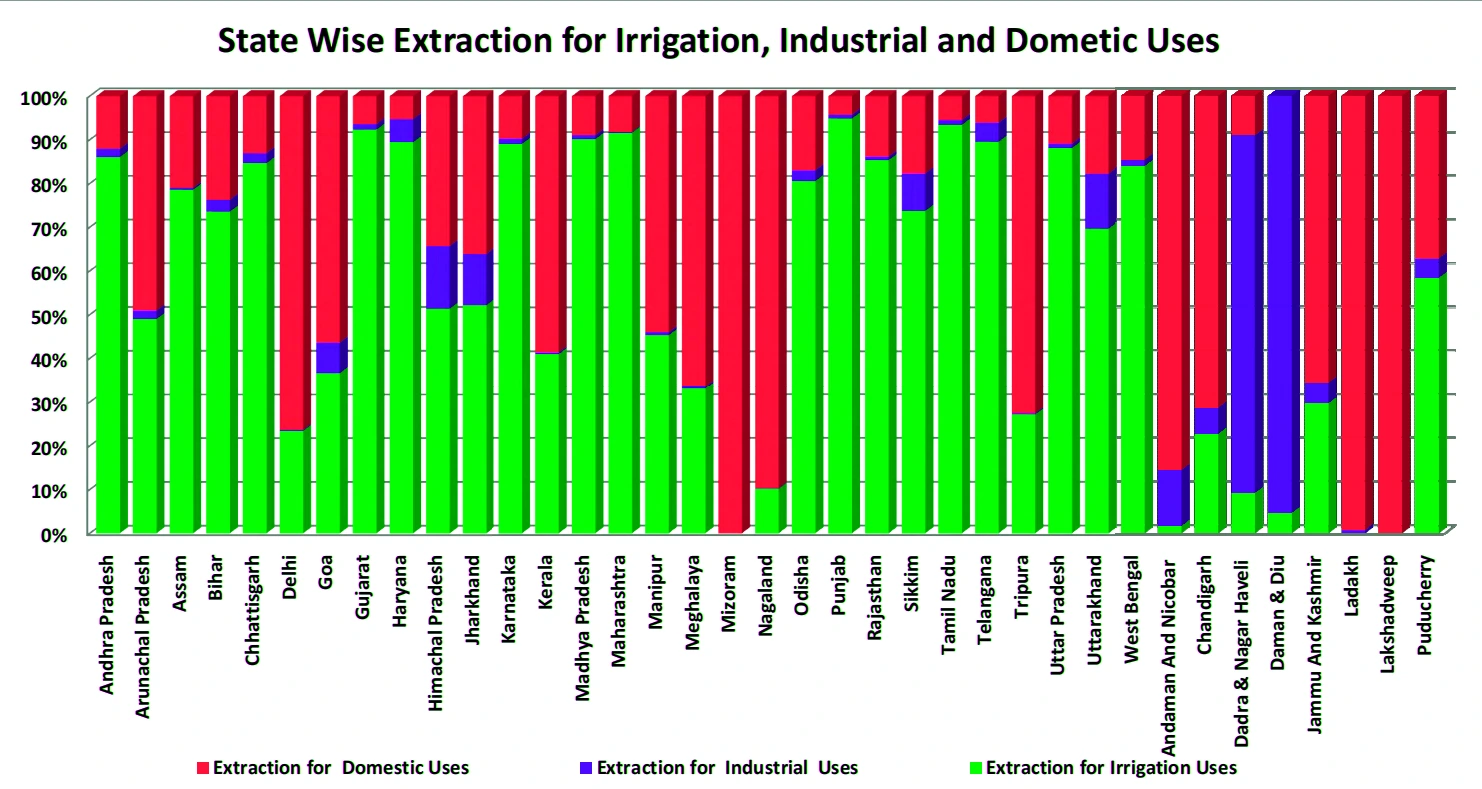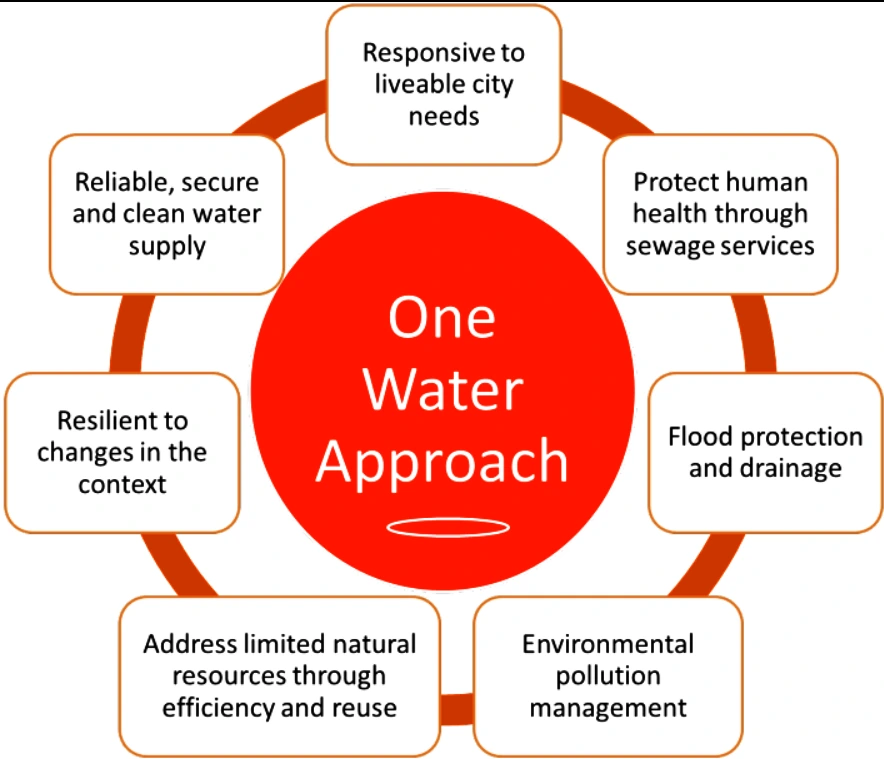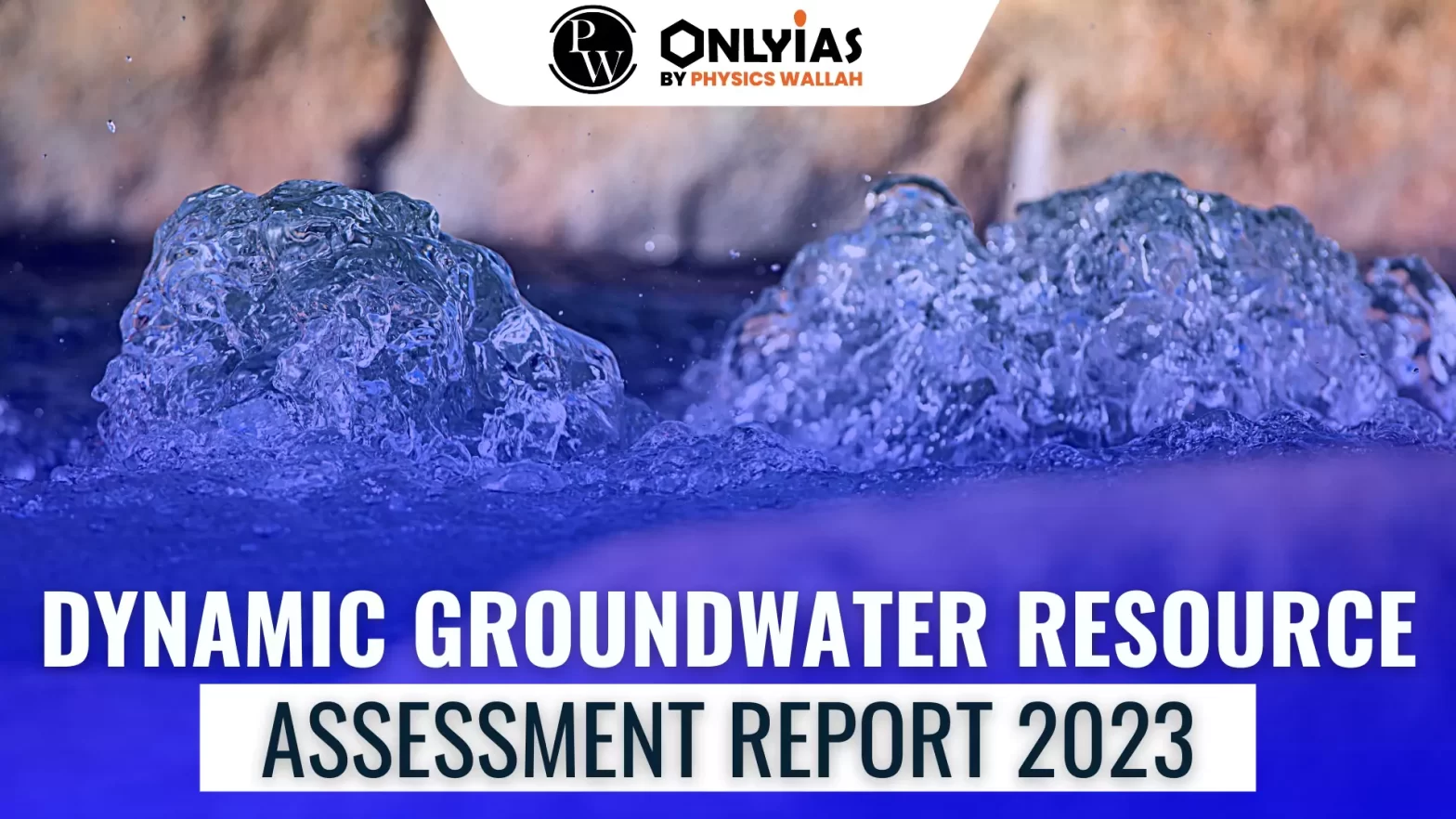Context: This article is based on the news “Ministry of Jal Shakti releases Dynamic Ground Water Resource Assessment Report 2023” which was published in the ANI. The Ministry of Jal Shakti has recently released the Dynamic Ground Water Resource Assessment Report 2023.
| Relevancy for Prelims: Dynamic Groundwater Resource Assessment Report 2023, State Groundwater Departments (SGWD) and Central Groundwater Board (CGWB), Pradhan Mantri Krishi Sinchai Yojana (PMKSY), Jal Shakti Abhiyan, New National Water Commission (NWC), and Mihir Shah Committee.
Relevancy for Mains: Groundwater Management in India: What challenges are associated with it, Steps has the Indian government taken to improve groundwater management and solutions? |
About Dynamic Groundwater Resource Assessment Report 2023
- Groundwater Resource Assessment is carried out at periodical intervals jointly by State Groundwater Departments (SGWD) and Central Groundwater Board (CGWB).
- Such joint exercises were carried out in 1980, 1995, 2004, 2009, 2011, 2013, 2017, 2020 and 2022. From 2022, the exercise is being carried out annually.
- Assessment involves computation of:
- Annual Extractable Ground Water Resource.
- Total Current Annual Ground Water Extraction.
- Assessment Method: Stage of Ground Water Extraction
- The stage of groundwater extraction in an assessment unit is calculated as the ratio of annual groundwater extraction to annual extractable resource.
- Based on this, the assessment units (Talukas/blocks/mandals) are categorised as safe, semi-critical, critical, or overexploited, which are then validated with long-term water level trends.

Also Read: 8th India Water Impact Summit (IWIS)
What are the major findings of the Dynamic Groundwater Resource Assessment Report 2023?
- Groundwater Recharge: The total annual groundwater recharge for the entire country is 449.08 billion cubic meters (BCM), marking an increase of 11.48 BCM compared to the previous year (2022). This increase may mainly be attributed to increased recharge from canal seepage, the return flow of irrigation water, and recharges from water
- bodies/tanks and water conservation structures.

- Groundwater Extraction: It has marginally increased from 239.16 bcm to 241.34 bcm. The overall stage of groundwater extraction has marginally decreased from 60.08 % to 59.26 %. Keeping an allocation for natural discharge, the annual extractable groundwater resource has been assessed as 407.21 bcm.
- Critical Level: In 3.04 % of assessment units the stage of groundwater extraction is between 90-100% and has been categorized as critical.
- Semi-Critical Level: There are around 10.65 % semi-critical units, where the stage of groundwater extraction is between 70 % and 90 %.
- Safe Level: There are around 73.14 % safe units, where the stage of Groundwater extraction is less than 70 %.
- Saline Units: There are 1.94% assessment units categorised as saline as a major part of the groundwater in aquifers in these units is brackish or saline.
- Groundwater Condition: Report indicates improvement in groundwater conditions compared with 2022 assessment data with out of a total of 6553 assessment units, 4793 units categorised as ‘Safe’.
Rainfall and Replenishment of Groundwater:
- It contributes to nearly 60 % of the total annual groundwater recharge.
- Over 75% of the annual rainfall is received in the four rainy months from June to September only thereby leading to large variations on temporal scale.
|
What challenges are associated with groundwater management in India?
- Over Exploitation of Groundwater: The over-extraction of groundwater for agricultural, industrial, and domestic purposes has led to declining water tables in many regions, resulting in the depletion of aquifers.
- Out of the total 6553 assessment units, 736 units(11.23%) have been categorized as over-exploited, indicating groundwater extraction exceeding the annually replenishable groundwater recharge.
- For example, in the northwestern part of the country including parts of Punjab, Haryana, Delhi, and Western Uttar Pradesh where even though the replenishable resources are abundant, there have been indiscriminate withdrawals of groundwater leading to over-exploitation.

- Lack of Human Resources: According to the report, there is a lack of dedicated manpower at the district level for understanding data to be collected from different State Departments.
- For example, qualified human resources are needed so that data related to recharge from water conservation structures can be collected and regularly updated at the district or block level so that a more realistic assessment of groundwater resources can be accomplished.
- Groundwater Pollution: In many areas, groundwater is contaminated with pollutants, including industrial effluents, agricultural runoff, and untreated sewage.
- Poor water quality affects both human health and agricultural productivity, posing additional challenges for water management.
- According to a Lancet study, pollution in India has led to more than 2.3 million premature deaths in 2019, more than half a million were caused by water pollution.
- Climate Change Impact: Climate change affects rainfall frequency, and it is expected that climate change will significantly alter India’s hydro-climatic regime. These changes reveal that the Kharif crops will face more risk of floods and droughts.
- Increased variability in precipitation and more extreme weather events caused by climate change can lead to longer periods of droughts and floods, which directly affects availability and dependency on groundwater.
- Technological Challenges: The adoption of modern technology for water management, including efficient irrigation techniques and groundwater recharge methods, faces challenges in terms of accessibility, affordability, and awareness among users.
Also Read: India’s excess sugar production is guzzling groundwater
What steps has the Indian government taken to improve groundwater management?
- Master Plan for Artificial Recharge to Groundwater in India: It envisages implementation of nearly 11 million rainwater harvesting and artificial recharge structures to augment the groundwater resources of the country
- National Aquifer Mapping & Management Programme (NAQUIM): NAQUIM for mapping major aquifers, their characterization and formulation of aquifer management plans to ensure the sustainability of the resources, prioritising over-exploited, critical and semi-critical assessment units.
- Watershed Development Programmes: Several State Governments are implementing watershed development programmes, in which, groundwater conservation forms an integral part.Water conservation measures are also taken up as a part of the MGNREGA.
- Jal Kranti Abhiyan: Launched by the Ministry of Jal Shakti, it aims at consolidating water conservation and management initiatives in the country through a holistic and integrated approach involving all stakeholders.
- Atal Bhujal Yojana: It envisages improving groundwater management in identified water-stressed areas in parts of a few States in the country with emphasis on demand management and community participation.
- Pradhan Mantri Krishi Sinchai Yojana (PMKSY): PMKSY envisages the creation of irrigation potential from groundwater in assessment units where there is sufficient scope for further future groundwater development.
- Jal Shakti Abhiyan: This initiative is characterized by the expeditious execution of five interventions viz. water conservation and the harnessing of rainwater, revitalization of traditional and contemporary aquatic ecosystems, the recycling and replenishment of water, watershed development, and the deliberate augmentation of afforestation efforts.
Way Forward for Groundwater Management in India:
- One Water Approach: Shifting the attention from linear water management to a multi-dimensional integrated water management approach (One Water approach) for a comprehensive, resilient, and sustainable management of water resources.
- One Water: It is the recognition that all water has value, regardless of its source. It includes managing sources in an integrated, inclusive, and sustainable manner by benefits.

- Formation of New National Water Commission (NWC): The Mihir Shah Committee recommended that the CWC and CGWB should be restructured and unified to form a new NWC.
- According to the committee, a unified body will help in the collective management of ground and surface water and it will be responsible for water policy, data, and governance in the country.
- Promote Water-Efficient Agriculture: Encourage the adoption of precision irrigation techniques (drip and sprinkler systems), promote the cultivation of less water-intensive crops in water-deficit regions, and introduce crop diversification strategies.
- Data Collection and Management: Investing in human resources to ensure comprehensive data collection to assess groundwater availability, quality, and usage.
- Climate-Resilient Strategies: Develop and implement climate-resilient groundwater management strategies to address the impact of changing weather patterns.
- For example, ensuring treatment of alternative sources of water, increasing water storage capacity, ensuring river health and watershed management, etc.
- Technological Solutions: Promote the use of innovative technologies for efficient water use, such as sensor-based irrigation systems and soil moisture monitoring and further investing in research and development for affordable and sustainable water management technologies.
Conclusion:
The Dynamic Groundwater Resource Assessment Report 2023 highlights both positive trends and challenges, underscoring the need for a comprehensive and sustainable approach to groundwater management in India, incorporating technological innovation, policy restructuring, and community participation to ensure long-term water security.
| Prelims Question (2020)
Consider the following statements:
1. 36% of India’s districts are classified as “overexploited” or “critical” by the Central Ground Water Authority (CGWA).
2. CGWA was formed under the Environment (Protection) Act.
3. India has the largest area under groundwater irrigation in the world.
Which of the statements given above is/are correct?
(a) 1 only
(b) 2 and 3 only
(c) 2 only
(d) 1 and 3 only
Ans: (b) |
![]() 5 Dec 2023
5 Dec 2023




